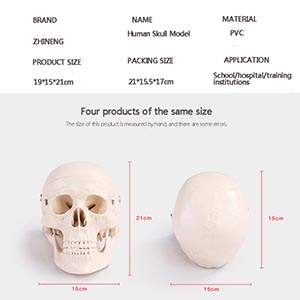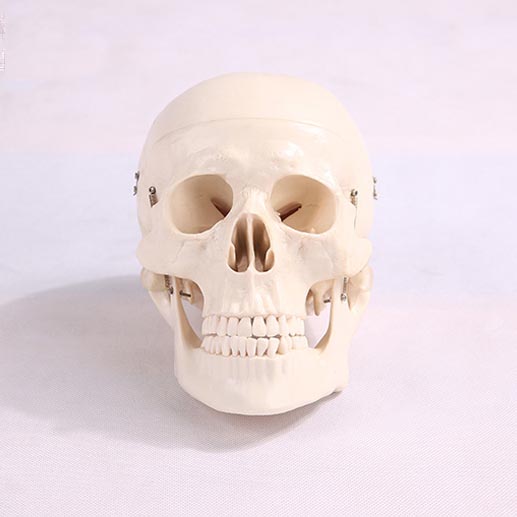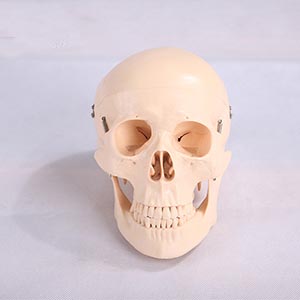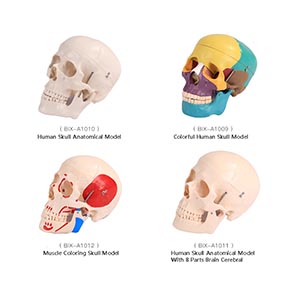Homepageпјҡ NEWS >> Why are large skull models better for basic medical education?
In medical education, basic anatomy is one of the core contents that every medical student must master. The complexity of human anatomy requires students to have sufficient intuitive understanding in the learning process, and large skull model, as a common teaching tool, has become an indispensable part of anatomy education with its high operability and sense of reality. Although modern medical education has gradually introduced virtual reality (VR), augmented reality (AR) and other technologies, the large skull model still occupies an important position in basic medical education with its irreplaceable advantages. So why are large skull models particularly suited to basic medical education? This article will explore the unique role of large skull models in anatomy education from an academic perspective.
1. Provide intuitive 3D structure understanding

The large skull model, with its realistic three-dimensional structure, helps students intuitively understand the various anatomical parts of the skull. This advantage is not achievable in a traditional two-dimensional textbook or screen image. The structure of the human skull consists of complex bone connections, sinuses, pores and joints, etc., which need to be accurately displayed through three-dimensional forms.
By holding or manipulating a large skull model, students are able to view and touch different parts of the bone from multiple angles, forming a more comprehensive spatial awareness. Especially in basic medical education, students are usually first exposed to human anatomy, and this intuitive way of learning can help them better understand theoretical knowledge. For example, students can look at and touch the model to gain insight into the relative positions and connections of the various parts of the skull, such as the frontal bone, temporal bone, parietal bone, etc., as well as the distribution of cavities and nerve pathways in the middle of the skull.
2. Strengthen the connection between anatomical structure and clinical practice
Although the teaching of basic anatomy focuses on pure structural cognition, it is equally vital for medical students to integrate anatomy with clinical applications. Large skull models can help students combine abstract theoretical knowledge with practical clinical scenarios. For example, through models, students can understand how head trauma, skull fractures occur, or how important anatomical structures can be avoided during brain surgery.
Studies have shown that by using models in basic education, students are able to understand anatomy much earlier as a guide to clinical practice. According to a study of 300 medical students, those who taught using anatomical models, including large skull models, scored 18 percent better on later clinical skills tests than those who did not use models. This data shows that early model learning not only helps students improve their grasp of theoretical knowledge, but also helps them apply this knowledge to clinical operations.
3. Simulate complex anatomical structures to improve memory and understanding

Large skull models not only help students with spatial perception, but also help them remember complex anatomical details. Through the manipulation of the model, students can strengthen the memory of the skull's various bones, joints, pores and other important anatomical markers. Traditional learning methods, such as paper textbooks and two-dimensional images, often struggle to clearly represent these details, but models can help students to visualize this information and help them remember it better.
One study showed that students who learned anatomy through models had a 30% higher retention rate of anatomical details than students who learned anatomy through traditional images. This highly operable and interactive learning method can effectively enhance students' learning motivation and sense of participation, and thus enhance their long-term memory of anatomy knowledge.
4. Reduce the risk of clinical operation and ensure safe training
The large skull model can effectively avoid the risks of practical clinical operation in basic anatomy training, especially for beginners. Students are able to practice repeatedly on the model while learning procedures such as intramuscular injections and head surgery without having to touch the patient directly. This simulation environment can help students get familiar with the operation process, master the necessary skills, and reduce the operational errors that may be encountered in actual clinical practice.
For example, many medical training institutions have adopted large skull models for brain surgery simulation training, and students can perform craniotomy, fracture repair and other operations on the model without worrying about patient safety. This provides students with a risk-free learning environment that enables them to confidently face challenges in clinical practice.
5. Efficient and economical learning resources

The use of large skull models is more efficient and economical than that of human anatomy or clinical practice. For one thing, live-action anatomy courses are often resource-limited, and the acquisition and preservation of dissected bodies are costly, while large skull models are inexpensive to maintain and reusable. Second, students can use models for revision and self-directed learning at any time and place, without the need to rely on specific laboratory conditions or patients.
In addition, the variety and refinement of the model make it an ideal tool to adapt to the needs of different disciplines. For students of medicine, dentistry, maxillofacial surgery and other majors, the use of natural large skull models can help them understand the basic structure of the skull at the basic stage, and lay a solid foundation for subsequent clinical skills training.
6. Data support and research results
Studies have shown that the use of anatomical models has significant effects in basic medical education. A study of 500 medical students showed that those who used a large skull model as a teaching aid had better anatomical knowledge and practical skills than those who did not use the model, and the latter were 20% more likely to pass clinical trials. These data fully prove the high efficiency and practicability of large skull model in basic medical education.

Conclusion: The central role of the large skull model in basic medical education
The large skull model has become an important tool in basic medical education by providing an intuitive three-dimensional presentation of the structure, helping students understand the connection between anatomy and clinical practice, strengthening memory and understanding, ensuring safe training, and providing efficient and cost-effective learning resources. With the continuous development of medical education, the application of models in teaching will be more and more extensive, especially in the early anatomy training, to help students master the basic knowledge of human body structure and develop their clinical skills. Whether in traditional teaching or in the future education mode combined with virtual technology, the large skull model will continue to play an irreplaceable role.